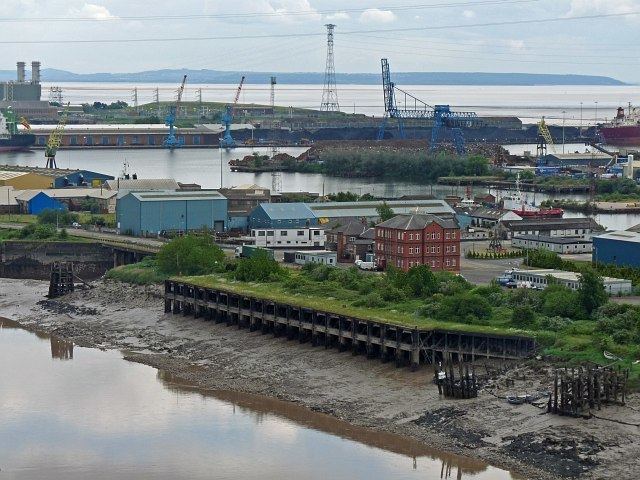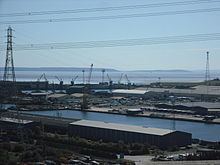 | ||
Similar | ||
Newport docks
Newport Docks is the collective name for a series of docks in the city of Newport, south-east Wales.
Contents
- Newport docks
- Musco lighting associated british ports newport docks
- Background
- History of the Old Town Docks
- The Newport Docks Disaster
- Rail connections
- Pontypridd Caerphilly and Newport Railway
- Chronology
- Later history
- References
Musco lighting associated british ports newport docks
Background

Newport was a small fishing port and market town until the coming of the industrial age at the beginning of the 19th century. The Monmouthshire Canal, opened around 1800, was used to bring down coal from the coal mining operations and iron from ironworks in the South Wales valleys for shipment abroad and around the UK, and soon Newport's docks were doing more business than almost any other port in the United Kingdom.
History of the Old Town Docks
In the early decades of the 19th century, Newport's maritime trade was served by wharves along the River Usk, a tributary of the River Severn estuary. These waters exhibit the second highest tidal reach in the world and improved facilities became needed, particularly for larger American vessels which risked damage when beached at the wharves at low tide. The expansion of trade caused by the development of the canal system had led to rapid growth of coal and iron exports from Newport's hinterland. If the town were to continue to prosper and compete with the growing port of Cardiff a floating dock protected by lock gates needed to be constructed.

In March 1835, a public meeting was held at the King's Head Inn and plans for a floating dock were agreed. A committee was appointed to devise a Bill to be put before Parliament. In July the Newport Dock Act was given Royal Assent for construction work to commence.
The estimated £35,000 cost was covered by selling 350 shares at £100 each. On 1 December 1835 the Mayor of Newport, John Owen, cut the first sod, celebrated by the ringing of the bells at St Woolos and the firing of guns.
Progress was slow. As a result of the rise of Chartism and an organised labour movement there were labour disputes. More money was raised in 1838, 1840, 1841 and 1842 by which time the estimated cost had exceeded to £140,000. In September 1842 workers walked out demanding higher wages and had to be suppressed by armed police.
Eventually and official opening took place on 10 October 1842, marked by festivities attracting tens of thousands of visitors. A mile-long procession made its way along High Street, Commercial Street and Commercial Road (which led towards the new Dock) headed by the Mayor and Aldermen in open carriages.
At 10 o'clock the lock gates were opened, as the Monmouthshire Merlin reported, to the sound of “the shouts and cheers of the spectators, the thunder of cannons, firing of musketry and pealing of bells.” The first vessel to enter the dock was the Henry.
Following the official opening the programme of events continued throughout the day. Highlights included a dinner for 300 gentlemen of the area at the National School, boat races on the dock reservoir and a firework display at Rodney Wharf. In the evening a ball was held for the gentry at the King's Head Hotel. The Clubs and Societies also held their own balls and dinners at Inns throughout Newport, a Tradesman's Ball at the Steam Packet Inn was reported to have “kept up with much spirit until morning”. The Monmouthshire Merlin newspaper does not report on how the town's population felt the next day!
However, shortly after its opening it was apparent that what had become known as the Town Dock was insufficient to deal with the ever-increasing volumes of trade. In July 1854 a second act was passed giving the Newport Dock Company permission to extend the Town Dock to the north. Work commenced in June 1856 and was completed in less than two years. The official opening on 2 March 1858 was declared a local public holiday and was greeted with similar celebrations to the 1842 opening.
The Town Dock expansion was not initially the success that the Newport Dock company hoped for and the company faced severe criticism, especially after they increased their charges. It was now obvious that the Town Dock alone was no longer sufficient to meet the volume of trade passing through Newport. In 1865 an act was passed to allow the construction of a second dock and in 1868 work began on the Alexandra Dock, which opened in 1875. Unsurprisingly, the opening of the rival dock had a detrimental effect on the trade of the Town Dock, although it was the accident involving the Constancia and the Primus which ultimately led to the demise of the Newport Dock Company.
On 10 January 1882 the two vessels attempted to pass through the lock at the same time but the Primus became stuck on the sill of the outer gates and the ships collided. The Monmouthshire Merlin describes how the situation became critical as the tide began to recede because "the bottom of the lock being concave in form, as the water ebbed the steamers heeled over one on the other, the Primus carrying away her masts, breaking in two amidships and, of course, subsiding to the bottom, whither she was followed by her companion in misfortune." The lock was completely blocked and the vessels already in the dock trapped for nearly two weeks. The accident incurred substantial expense for the Newport Dock Company and further eroded customer confidence in the company. A year later the Newport Dock Company was sold to the Alexandra Dock Company for £150,000. From this moment the Town Dock was used for dealing with the smaller vessels whilst larger cargoes were concentrated at the Alexandra Dock. However, its relatively small size and position further up the Usk's estuary than the Alexandra Dock made the Town Dock particularly vulnerable.
The Alexandra Dock was further extended southwards with the addition of the South Dock (which in time assume the original dock's name) opened in 1892 while the original Alexandra Dock became known as the North Dock. By 1900 the Town Dock was being used primarily for the general import trade, particularly timber. An even bigger westward extension to the Alexandra (South) Dock was opened in 1907. It was even further expanded and a new South Lock (the Great Sea Lock) opened in 1914 with direct access to the Severn Estuary.
The Newport Docks Disaster
The Newport Docks Disaster occurred on 2 July 1909 when, during construction of the new South Lock, supporting timbers in an excavation trench collapsed and buried 46 workers. The rescuers included 12-year-old paper boy Thomas ‘Toya’ Lewis who was small enough to crawl into the collapsed trench. Lewis worked for two hours with hammer and chisel in an attempt to free one of those trapped who was released the next day. Several hundred pounds was later raised through public subscription in gratitude for the boy's efforts, and he was sent on an engineering scholarship to Scotland. Lewis was awarded the Albert Medal for Lifesaving by King Edward VII in December 1909. A Wetherspoons pub in the city centre is today named "The Tom Toya Lewis" after the young hero.
The Town Dock was unable to survive the downturn in trade in the 1920s the Town Dock was finally closed in October 1930 and filled in by 1939.
Rail connections
The docks already had connection to
But the need for transportation capacity to the colleries in the upper Aberdare and Rhondda valleys was escalating, as the number of shafts sunk and coal produced quickly escalated.
During 1877 at a board meeting of the Alexandra (Newport) Docks and Railway Company (ANDR), Lord Tredegar and Sir George Elliot of Powell Duffryn collieries agreed that the only way to secure the future income of the Alexandra docks was the provision of a direct railway route. The MP David Davies offered financial assistance, but withdrew his offer at a later date as he became involved with the Barry Docks and Railway Company.
Pontypridd, Caerphilly and Newport Railway
Although formed by the same directors of the Alexandra Docks & Railway Company, the Pontypridd, Caerphilly and Newport Railway was formed as a separate company to the Alexandra Docks & Railway Company for various investment, tax, political and operational reasons. Incorporated by an Act of Parliament on 8 August 1878, the line was engineered by Sir James W. Szlumper, and double tracked from Pontypridd to Rhymney, where it joined the metals of the Rhymney Railway at Penrhos junction to access Caerphilly station.
Local passenger trains terminated at Caerphilly, but through passenger and freight services continued over the Brecon and Merthyr Railway's Caerphilly branch to Bassaleg, where at West Mendelgief junction the PC&NR trains joined the metals of the Alexandra Docks railway; through passenger services terminated at Newport railway station for connection to either the Great Western Railway or the London and North Western Railway.
The single track from Caerphilly to Bassaleg provided both too little capacity for the freight traffic, as well as a challenging 1:39 climb out of Caerphilly station for loaded trains. The Machen Loop Act of 1887 gave the PC&NR the right to double track the route, with a diverged route from Gwaun-y-Bara junction to Machen providing a 1:200 slope for loaded trains. The new double track came into operation on 14 September 1891, and was immediately transferred to the Brecon and Merthyr Railway; which in return paid 50% of the annual net earnings from the Caerphilly branch to the PC&NR.
In 1883, PC&NR agreed a plan to use the Nixons Private Railway and Powell Duffryn Private Railway to run up the valley from Abercynon to Aberdare.
Chronology
The chronology for the line is as follows:
Later history
Only one locomotive still exists this day into preservation. Built in 1897, ex-Alexandra (Newport and South Wales) Docks and Railway 0-4-0ST GWR No.1340 "Trojan", is restored to working order, and currently residing at the Didcot Railway Centre.
